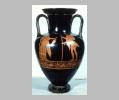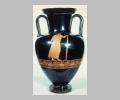
Side A: overview

Side B: overview
| Collection: | Kelsey Museum of Archaeology, the University of Michigan |
| Summary: | Side A: woman and young warrior pouring libation. Side B: old man leaning on staff. |
| Ware: | Attic Red Figure |
| Painter: | Attributed to the Berlin Painter |
| Date: | ca. 475 BC |
| Dimensions: | h. 34.3 cm; h. from base to fillet (at juncture of neck and body) 24.2 cm; h. from fillet to mouth 10.2 cm; h. of figures 10.8 cm; d. at rim 15.1 cm; w. at top of neck 10.2 cm; w. at mouth 10.2 cm; w. at base of neck 9.1 cm; w. at base 9.5 cm; w. at shoulder 20.9 cm. |
| Primary Citation: | |
| Shape: | Nolan amphora |
| Beazley Number: | 5157 |
| Period: | Late Archaic |
Decoration Description:
The fabric is an orange-red clay. A shiny, black glaze, unevenly applied, covers the exterior body of the vase, except for palmettes beneath the handles and the figure scenes on both sides, beneath which runs a reserved band of decoration consisting of an alternating lotus and palmette pattern. Black relief lines: Side A: eyebrows, eyes, ears, chins, and necks; dots for hair at foreheads, faces and necks; folds of chlamys and chiton of youth, outline of cup, articulation of spear; outline of woman's fingers of right and left hands, left arm; folds and border of chiton and folds of himation; youth's upper thighs, ankle bones, toes of both feet and heel of right foot; feet, toes, and ankle bones of woman. Side B: eyebrow, eye, ear, and neck, outline of right hand, shoulder, underarm and fingers; outline of left hand; heels, arch of right foot, ankle bones and toes; dot rosette for nipple; front profile of right leg; folds of himation. Light reddish dilute glaze: Side A: fillet, folds of chiton, leg muscles of youth; folds and decorative band of chiton, x-decoration on himation. Side B: hair, ear, arm, shoulder, and neck muscles. Narrow line between double band below lotus-palmette pattern. Palmette decoration outlined; some delineation within palmettes. Dark red glaze: Side A: bracelets, ribbon of woman's hairnet. Side B: wreath.
An ornamental band of an alternating lotus and palmette pattern, enclosed within a single line at the top and double lines at the bottom, encircles the body of the vase and serves as ground line for the figure scenes. One large inverted palmette projects from the base of each handle. On Side A a woman and a young warrior are pouring a libation. The woman, facing left, holds an oinochoe in her right hand, a fold of her garment in her left. She is clad in a long himation, decorated with an x-design over the bosom, worn over a loose-sleeved Ionic chiton. Her long hair is fastened behind by a tasselled ribbon in a snood, which hangs from the back of her tiara. Her feet are bare and on each forearm she wears a snake bracelet. Facing her, a young warrior holds a spear in his left hand. With his right hand he extends a broad phiale towards her (The stem which makes the vessel look like a kylix is an erroneous modern restoration.). He is dressed in a short chiton with a chlamys falling from his shoulders. He is barefoot, and his short hair is bound by a fillet. Side B depicts an aged man, standing facing left, leaning his right hand on a knotted staff. He wears only the himation and a wreath of leaves on his head. His hair is close-cropped; he has a full, spade-like beard, and is barefoot.
The attribution to the Berlin Painter was made by Nicholls. The Berlin Painter excels in the simplicity of composition and in the innovative placement of one or two figures unrestricted by any or very little ornamental border; often referred to as a "spotlight technique." The figures are elegant and majestic in their slender proportions. His use of relief line is sparing but fine and his delicate drawing of the anatomy and facial features is characteristic. Musculature is painstakingly detailed in dilute glaze. His painting of drapery is characterized by long, flowing lines denoting supple creases and folds. In the features of the young man and woman there is a subtle blend of innovation and tradition, of late archaic and early classical elements, reminiscent, in sculpture, of the Athena from the west pediment of the Temple of Aphaia at Aegina and the Kritios Boy, ca. 480 B.C.
A scene on a kalpis by the Berlin Painter in the Kunsthistorisches Museum (
The scene is most likely a sacrifice before a young warrior's departure for, or upon his return from, battle. There is a hoplite shield propped up behind him, incised, but never painted. The military subject of the scene reflects Athenian political events at the end of the first quarter of the fifth century B.C., after the Persians had been defeated in Greece. The wreath on the head of the old man suggests a festival of victory or thanksgiving, perhaps for the young warrior's safe return.
The Nolan shape is most favored by the Berlin Painter in his late period (475-465 B.C., according to Cardon, infra, p. 175). Two Nolans from the late period, one in Carlsruhe (
Shape Description:
The shape is of the Nolan type, with high neck, broad shoulders, and pointed base. The two loop handles connecting the sides of the neck with the shoulders have triple vertical ridges. The vase has an echinus mouth and torus foot with a reserved band at the bottom.
Essay:
Collection History:
Museum purchase (77.7.1). Ex Collection Lord Belper, Kingston Hall, Nottingham, England.
Sources Used:
Other Bibliography:
The Berlin Painter and His School (Dissertation, New York University 1977) 175, no. 243, pl. XCIX